Why Google's new AI search may be a bad deal for users
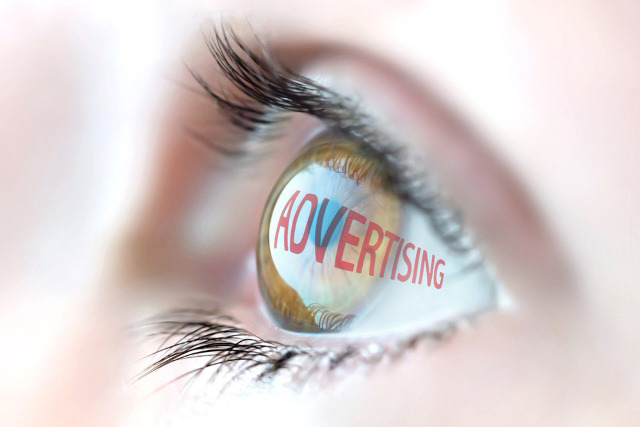
Google says its new generative AI feature will start a "new era of search" by "unlocking new types of questions" and "transforming the way information is organized." But a closer look at Google’s own promotional materials reveals a downside: you may have to face a barrage of ads every time you use it. But how many ads is too many? For Google, it seems, there is no limit.
Google offered a sneak peek at ad placements in its brand new Search Generative Experience (SGE) at an event for advertisers on May 23. There, Google revealed that ads would not only appear before and after the AI-powered snapshot, as originally announced, but would also infiltrate the AI-generated responses. And if the example Google gave is anything to go by, it's not a pretty sight.
In the example provided by Google, an SGE user searched for "outdoor activities in Maui" and was greeted by two Google ads at the top of the search results before he could even see the AI’s suggestions. After scrolling down, the user could see some tips on outdoor activities to enjoy in Maui, framed in green to indicate that they were generated by AI.
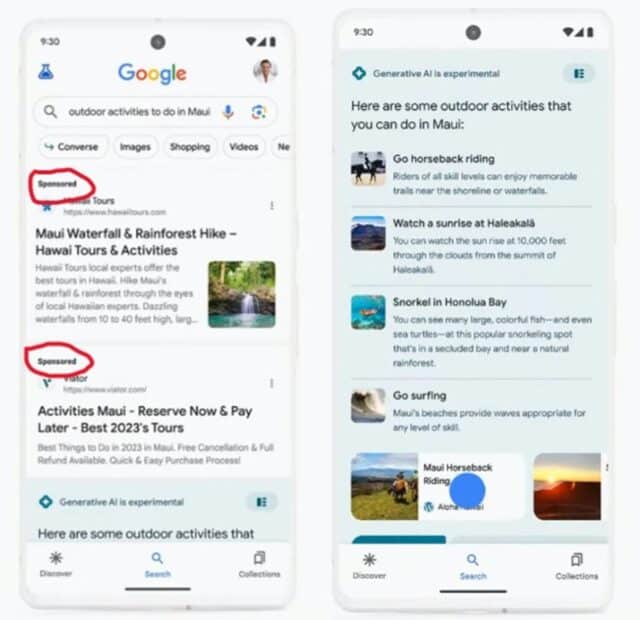
The first AI-generated response was ad-free, but the first follow-up question to the AI chatbot -- "hiking backpacks for kids" -- triggered an answer that already included ads. A sponsored result came first, followed by organic results.

'Industry-leading' ad labels that hide in plain sight
Touting the "new ad experience”, Google’s VP of Ads Jerry Dischler claimed that search ads within SGE would be hard to confuse with organic results. The former would "feature our industry-leading clear and transparent labels with the 'Sponsored' label in bold black text," he said.
However, if you look at the backpacks in the screenshot above, without peering too intently, you may not be able to tell which one is the advertised one (or if they all are). That’s partly because, in Google’s example, other products also have labels: "good for mountain biking" and "good for kids," which make the "sponsored" label less noticeable. Besides, what catches the user’s attention first is arguably the product image, the description and the price, and not a line of text in fineprint at the top.
VP of Google Ads Vidhya Srinivasan described the new ad placements as a "beautiful moment" for advertisers to reach users with highly-relevant ads. A rather surprising choice of words, because we don’t see anything beautiful about making organic search results and ads look more alike, even if it helps advertisers to attract customers.
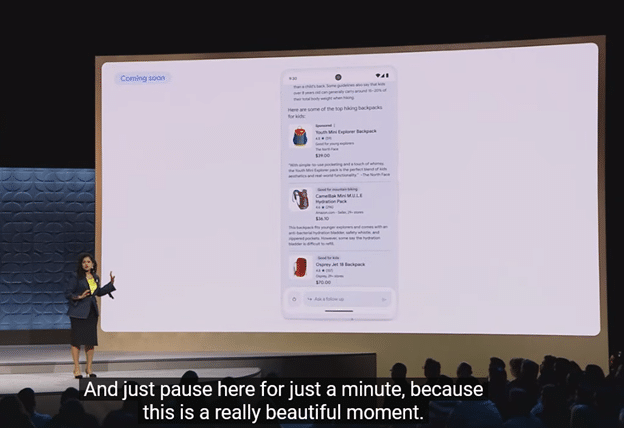
Anyone familiar with Google's history of ad labeling knows that over the years, Google has made ads in search more and more indistinguishable from organic search results. First, by removing background shading in 2013, and then by doing away with colored ad labels in 2019. Google's claim that its ad labels are "industry-leading" is questionable, but even if we assume it’s true, it is not a compliment to Google, but rather a criticism of the industry’s poor standards for marking ads clearly.
As for "clear and transparent", well, judging by the direction Google's ad design is going, it seems that at some point the labels may become so "transparent" that we will barely be able to see them at all. Right now, it's already hard to tell the difference between paid and natural results in SGE.
Ads galore
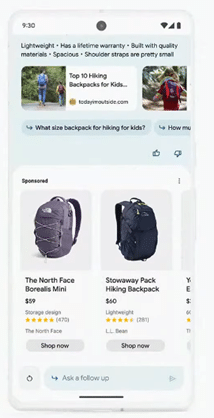
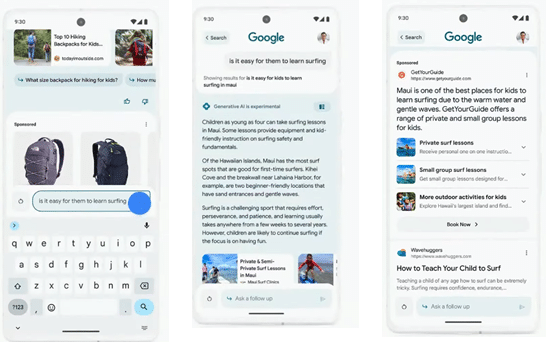
But let's go back to ads in the SGE.If the user scrolls to the bottom of the SGE experience, they'll see another row of ads.
And if the user, assuming they are still not deterred by the amount of ads at this point, decides to ask more follow-up questions ("is it easy for them to learn surfing" in Google’s example), they should be ready to see more ads in replies.
The fact that Google is filling its Generative Search Experience with ads from day one is not surprising. After all, Google makes most of its money from advertising, and search ads account for a lion share of its ad revenue. To some extent, Google follows in the footsteps of Microsoft, which introduced ads into Bing AI, its own AI-supercharged search experience, back in April.
Blocking ads in Google’s SGE
Based on our initial observations, it seems that ads in Google's SGE are similar to the ones in regular Google Search results, and can be blocked with conventional ad blocking methods. The way the ads appear, as seen in the videos and screenshots Google has provided, does not require us to come up with new, out-of-the-box solutions.
However, there's a risk that Google could take a page from Bing's playbook and integrate ads more closely or "natively" with AI-generated responses, making them an integral part of the message itself. In that case, simply removing the ads could render the entire response unhelpful, meaning we would have to explore innovative ways to block ads, perhaps using AI ourselves. We have discussed some of these possible new methods in more detail [in our article about the challenges of blocking ads in Bing AI's chat mode.
We may change our opinion once we take a closer look under the hood of Google’s SGE. For now, we are cautiously optimistic that we will be able to block ads in SGE, which the most quick-witted have already nicknamed Google’s "Generative Ads Experience."
Trade-off between innovation and ads: what will users choose?
Google’s AI-powered Search Generative Experience (SGE) is a new feature that aims to create a better user experience in search, but Google risks achieving the opposite by inserting too many ads into its already ad-heavy product. While we wouldn’t expect Google to refrain from including ads in SGE — after all, Bing populates its AI chatbot with them as well -- an excess of ads can backfire. If that happens, Google will see a decline in the number of users who stay with SGE over time.
Users who want to avoid most ads in search results have some options. They can use an ad blocker, such as AdGuard, which can block ads from Google and other sources. There’s no doubt that companies like Microsoft and Google will keep finding new ways to insert ads into their conversational AI responses, but ad blockers will also be working on finding new ways to block them.
Another option is to use a paid search engine, such as Brave Search Premium, which offers an ad-free and private search experience. Unfortunately, Neeva, another ad-free subscription-based search engine, has recently shut down. They had a noble vision of offering users personalization and privacy without ads, but they struggled to get users to switch from their default search settings. This shows how hard it is to compete with Google’s dominance in the search market. But if Google fails to balance its AI innovation with its pursuit of ad revenue, it may open up opportunities for competitors. It's a long shot, but we'd like to see it happen, because more diversity and choice in search will benefit users and the industry itself in the long run.
Photo credit: sindlera / Shutterstock
Andrey Meshkov is a co-founder and CTO of AdGuard.
.
